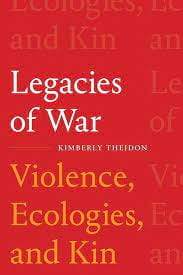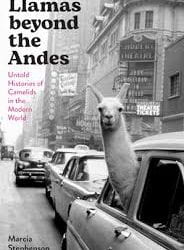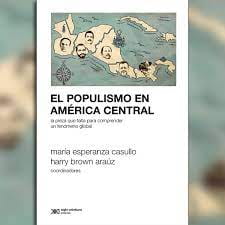A Review of Legacies of War: Violence, Ecologies and Kin
In 1962, Colombian artist Alejandro Obregón unveiled La Violencia, one of his most iconic oil paintings. Imposing in its dimensions, the 61×73 inch canvas appears, initially, to be just a mountainous landscape rendered in nebulous whites and various shades of black. A closer inspection, however, reveals a horizontally extended figure amid the dark hues: the corpse of a mutilated, pregnant woman.
Obregon’s disturbing painting is not alone in calling attention to the close relationship between violence, female bodies and landscape in Colombia: already in the 19th century, as historian Nancy Appelbaum has shown, many travelers and explorers identified an association between the country’s lush mountain ranges and the fratricidal brutality unleashed by their inhabitants for centuries. A similar theme pervades Apitchatpong Weerasethakul’s film Memoria (2021), in which a Scottish expatriate (played by Tilda Swinton) living in Colombia, is haunted by loud booming sounds which seem to emanate from the memory-pregnant landscape. It is far from a coincidence, then, that gendered violence and its manifold effects have been scrutinized to the utmost extent by some of the strongest female voices in Colombian literature—Pilar Quintana and Laura Ortiz, for example, but also recently “rediscovered” authors such as Elisa Mújica and Marvel Moreno.
Legacies of War: Violence, Ecologies and Kin by Kimberly Theidon (Duke University Press, 2022, 120 pages)
Theidon seeks to lay the interdisciplinary foundations for a novel “vocabulary of violation,” thus contributing to a comprehensive “gendered theory of harm.” The recognition if this gendered theory continues to be missing from national policies and current international agenda. It is in the “test case” of Colombia, specifically, that she identifies the first encouraging —though by no means sufficient—steps towards a deeper understanding of the “interrelatedness of harm” in war-ravaged territories. In 2011, the Colombian government recognized children born of sexual violence as “direct victims with a right to reparations.” Five years later, it also declared the legal personhood of the Atrato River and proclaimed it a casualty of armed conflict, thereby endowing the “more-than-human” with fundamental rights and moving towards ‘environmental and posthumanist conceptions of justice’ (59). In Theidon’s view, an exhaustive assessment of the successes and failures of the Colombian case may yield productive guidelines with which to radically transform how we understand and redress the multilayered legacies of war.
Throughout her book, Theidon relies on two distinct albeit connected strategies to buttress her arguments. The initial one consists in visibilizing all those “wounded warscapes,” both human and non-human, interior and exterior, public and private, which up until now have remained “hidden in plain sight.” To do so, she focuses on individual stories of harm instead of resorting to unquestioned notions or inherited frameworks which often obscure a phenomenon’s actual variety. Her book can be read, consequently, as a collection of “numerous stories, some of rejection and pain, others of love and care,” the narration of which eschews the totalizing “danger of a single story” (8). As Theidon puts it, “I advocate specificity and explanatory pluralism” (10). Such commitment to the concrete implies the sensible re-telling of personal testimonies—setting names, places and dates within a context—, as well as assuming and underlining the situated and subjective nature of the researcher. From the first page onwards, Theidon employs first-person narration, making explicit her research process and grounding it in her own perspective. In one of the most moving passages in the book, she recounts in vivid detail a life-threatening journey she undertook in 2001 in Urabá, Colombia, together with UN commissioners, members of the Catholic Church and one of the regional “Peace Communities”—self-organized “campesinos” who chose to reject any participation in the ongoing war. Theidon’s is only one among many stories.
Storytelling demands a certain “attentiveness to language use,” to use Theidon’s words (46). Relying on her critique of academic ethno- and eurocentrism, she delves into the semantic possibilities contained in Indigenous expressions such as the Quechua ‘mancharisqa ñuñu’ –translated as “frightened breast” or “teta asustada,” reflected in the title of the renowned 2009 Peruvian film—, which encapsulates the anxieties usually endured by wartime rape survivors regarding the ‘transmission of suffering from mother to child’ (38).
Similarly, a country like Colombia possesses a “wealth of expertise and information,” the cumulative knowledge of generations born and bred amid war; an archive of violence, as it were, which needs to be collected and put to good use. Native knowledge is thus taken seriously as “an ancestral legacy of trauma” and an underappreciated wealth of “sophisticated theories” which would be irresponsible to neglect. In this sense, Theidon argues that the routine usage of careless umbrella notions such as “stigma,” besides lacking true explicative power, tend to conceal the immense variety of sexual violence and its proper contexts. Worse still, they come with “an iterative, self-reinforcing dynamic” which gradually petrifies initial assumptions and naturalizes them. As Theidon states, “word associations matter” (10).
And no word carries more power than a name. Readers will be surprised by the sort of names some wartime rape survivors give to their undesired offspring: injurious names like “Chiki” —in Quechua, “danger.” The names reflect the brutality of the original conception, breeding unease and portending a menacing future, as do last names like “coronel,” “capitán” or “military,” which underline the fact that their mothers knew exactly “what the father was,” though not “who he was” (22). Mothers may choose to reject their children for a variety of reasons, from religious beliefs and scarce material resources to concerns about land inheritance, kinship networks and what Theidon calls “patriarchal biologies and theories of transmission”—fear that the aggressor’s malevolent character may manifest itself in the unwanted child.
But rather than speaking of unmotherly instincts and the like, as traditional views of womanhood would want it, Theidon pays attention to what these naming choices mean and do. According to her, they are nothing less than “an act of memorialization,” insofar as they “indict a communal failure” and condemn “the lack of solidarity with women who were the most structurally vulnerable” in the conflict (19). By deliberately engaging in such “speech acts,” women are refusing to be blamed for what happened, “attesting the legacies of violence in the present” and “denouncing the harm that was done and for which no redress has been found.” They become, in short, “counter-memory specialists” eager to disprove, correct or at least nuance the masculine, “official” history (18).
Other overlooked issues which Theidon chooses to bring to the fore include the difficulty of striking a balance between the “competing rights” of mothers and children; or, equally important, the ambivalent—not to say hypocritical—role played by the United States in the framing and implementation of UN policies and foreign aid programs, suffused with anti-abortion ideology and veiled geopolitical interests. And yet visibilizing, as crucial as it is, is only half of the whole undertaking, as Theidon’s second overarching strategy is to connect those seemingly disparate legacies of war and foreground their intimate interrelatedness. What seems a collection of disjointed and unrelated aspects, consequently, are shown to be just different expressions of the same underlying phenomenon. What is more, such an apparent unrelatedness is one of the most enduring outcomes of a certain idea of violence and post-conflict justice.
Near the end of her book, Theidon brings together its different threads while expounding on “how are things made to seem disparate’ (80). Blinded by anthropocentrism and human exceptionalism, on the one hand, we have forgotten what communities like the Amazonian Awá have long known, that the world is “Katsa Su,” “a whole including territory, people, and all species” (79). And seduced by the comforts of Western liberalism, on the other, we have been too confident about the usefulness of the human rights tradition in detecting the heterogeneity of gendered harm.
Theidon pinpoints similar shortcomings in Colombia’s legislation and recent rulings, its pioneering virtues notwithstanding. She also recommends embracing an all-encompassing notion of “maternal environment” that may aid us in identifying all sorts of “reproductive violence” and “ecological grief.” Additionally, she advocates for a supple vocabulary of gendered harm, capable of capturing the ‘continuity and magnification of each harmful act’ instead of regarding them as discrete, separated instances (90). As in her last book, Intimate Enemies: Violence and Reconciliation in Peru (2014), Theidon demonstrates in Legacies of War a unique ability to recognize, analyze and interconnect, with delicate sensibility and an innovative conceptual apparatus, the intricacies of invisibilized harm in complex post-conflict scenarios. The book should be recommended reading for policy makers and scholars interested in violence, its aftereffects and a posthumanist approach to justice and reparations.
Alejandro Quintero Mächler is a Research Scholar and half-time Lecturer in the Department of Romance Languages and Literatures at Harvard University. He is the author of Perder la cabeza en el siglo XIX. Ensayos sobre historia de Colombia e Hispanoamérica (2023).
Related Articles
A Review of Llamas beyond the Andes: Untold Histories of Camelids in the Modern World
Marcia Stephenson’s Llamas beyond the Andes is about humans making use of another animal. With a dustjacket image of Llinda Llee Llama riding in the back of an automobile in mid-20th-century Times Square, this book illustrates how sentient nature has been engulfed by human cultural objectives since Columbus’ arrival in the Americas and the rise of Europe’s global imperial ventures. The window on all this is American camelids: llamas, alpacas and their wild relations, guanacos and vicuñas.
A Review of Born in Blood and Fire
The fourth edition of Born in Blood and Fire is a concise yet comprehensive account of the intriguing history of Latin America and will be followed this year by a fifth edition.
A Review of El populismo en América Latina. La pieza que falta para comprender un fenómeno global
In 1946, during a campaign event in Argentina, then-candidate for president Juan Domingo Perón formulated a slogan, “Braden or Perón,” with which he could effectively discredit his opponents and position himself as a defender of national dignity against a foreign power.




